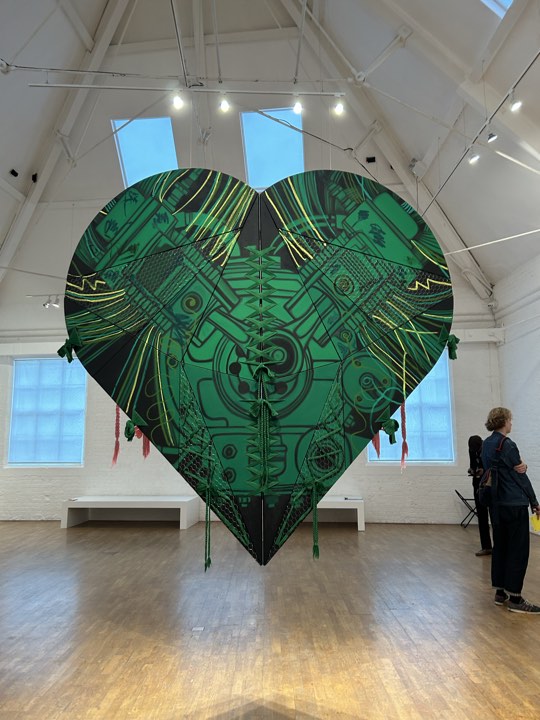Freida Toranzo Jaeger names her paintings like items in a manifesto: Extinction is the price we pay for our existence (2023), Open your heart because everything will change (2023), For new futures we need new beginnings (2022), Create to Destroy, Destroy to Create / On Taste and Poetry. Fuego (2019). Across the exhibition, Jaeger’s oil paintings are hinged together as sculptural installations. They stand as columns or hang from the ceiling. Four are tiny mechanical pyramids, opening and closing intermittently like automated origami fortune-tellers. Jaeger hopes her hinged paintings recall the foldable triptych altarpieces European missionaries carried across colonial Central America (Jaeger is Mexican and currently resident in Mexico City).
Thomas Gainsborough’s painting Mr and Mrs Andrews (1750) embeds its subjects in the landscape they own; the blank canvas where a baby could be painted is the unpainted patch of futurity nestled in Mrs Andrews’ skirt. And like Gainsborough, Jaeger puts the images of the future which the powerful invest in (today, the sleek space-age minimality of Elon Musk’s private space exploration company, Space X) in conversation with the Garden of Eden’s idyllic space-time. Jaeger’s dexterous selection of painterly approaches includes a neo-expressionist graffito line (that seems to be adopted from her Hamburg tutor, Jutta Koether) as well as flat, caricatured Eves snatched from fourteenth-century European painting and returned to us in the guise of Mexican muralism.
The kitsch, cute and reconfigurable in Jaeger’s work reframes the bloody history of European oil painting – so long the lapdog of the rich and powerful. Jaeger’s heart-shaped paintings, vibrant threaded bows and bedazzled celestial landscapes play on an impulse to crush the cute and critique the insipid. In Cybertruck (2020), an arbour of flat, painterly flowers adorns a car interior. Visible through the car window is a white strip painted with a minute fire. Lines of sgraffito slice through the white to produce a shattered effect. The painting’s title and this shattered centre recall the 2019 Tesla expo, where Franz von Holzhausen threw a ball bearing at the unveiled Cybertruck’s ‘Armour Glass’ shatterproof windows only to have the glass splinter. By recalling the meme-able moment, Jaeger invokes thousands of words worth of internet discourse, which has already made the ironic event into a tiny, recognisable emblem.
The paintings’ small fires are responsible for much of the allusive work: the fire of love, the home fires, the spark of the carburetor engine and the forest fires, which slide in and out of reality every record-breaking hot summer. In Cybertruck, Jaeger marks the fractured centre with the emblem of a tiny fire. Life Fears (2019) depicts a Pomeranian dog recoiling from flames on a plush red passenger seat. Jaeger is depicting our own half-life on the brink of climate breakdown. She seems to be satirising the rhetoric of techno-futurist billionaires and the like, who conceal their politics in the aesthetics of prophecy. “I don’t ascribe to any political party or economic model that currently exists,” tweeted Musk’s ex-partner, musician Grimes in 2022.
Jaeger concentrates on interiors: dashboards, vulvas, human organs, the garden of Eden and space-stations. The lungs of The powerful return of cosmic pessimism (2023) are painted onto a disk hanging low in the hinged prism-like diptych. Their pale snaking bronchi lead up to the red threads which suspend this smaller canvas in the centre of the two adjoining it. There is a synergy between the thread-like lung interior and the taut, twisted, looping threads which just touch it as they rupture the canvas. At this point of juncture Jaeger translates a stylised symbol into the complex, tactile material of the thread. The taut thread, which suspends the lungs, reminds us that our bodies cannot be disentangled from the space they occupy. After all, the easy, virtual rearrangement of images – the glimpses of heaven and hell reflected in the windows and wing mirrors of Deep adaptation on Audi Aicon 2020 costume design by H. Memling (2019) – finds its limit in the embodied, breathing body.
Jaeger’s relationship to the tradition of Mexican muralism – most widely recognised as the allegorical narrative wall-paintings by Diego Rivera – can’t quite be called a debt: Jaeger is conscious of the manual labour, political allegory and craft practices that tradition seeks to depict (although she chooses the traditionally girly or Latina pastimes of embroidery and rhinestoning instead). Yet Jaeger’s subject isn’t straightforwardly a political history of Latin America. Instead, she paints us a fiction of the future: a flattened world where delicate flowers, heart and lungs, space, as well as Adam and Eve, all have the solid, shiny surfaces of a Tesla’s interior. The endlessly customisable interior is beautiful and tactile, but there is only space for one or two on the inside.


